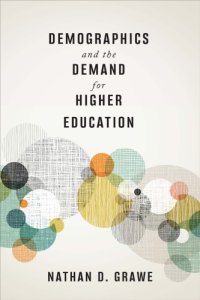
Ebook: Demographics and the demand for higher education
Author: Grawe Nathan D
- Tags: BUSINESS & ECONOMICS--Economics--General, Education--Demographic aspects, Education--Demographic aspects--United States, EDUCATION--Educational Policy & Reform--General, EDUCATION--Higher, Education Higher--Economic aspects, Education Higher--Economic aspects--United States, Education Higher--Forecasting, Education Higher--United States--Forecasting, Population, Population geography, Population geography--United States, SOCIAL SCIENCE--Demography, Universities and colleges--Administration, Universities an
- Year: 2018
- Publisher: Johns Hopkins University Press
- City: United States
- Language: English
- pdf
"The economics of American higher education are driven by one key factor--the availability of students willing to pay tuition--and many related factors that determine what schools they attend. By digging into the data, economist Nathan Grawe has created probability models for predicting college attendance. What he sees are alarming events on the horizon that every college and university needs to understand. Overall, he spots demographic patterns that are tilting the US population toward the Hispanic southwest. Moreover, since 2007, fertility rates have fallen by 12 percent. Higher education analysts recognize the destabilizing potential of these trends. However, existing work fails to adjust headcounts for college attendance probabilities and makes no systematic attempt to distinguish demand by institution type. This book analyzes demand forecasts by institution type and rank, disaggregating by demographic groups. Its findings often contradict the dominant narrative: while many schools face painful contractions, demand for elite schools is expected to grow by 15+ percent. Geographic and racial profiles will shift only slightly--and attendance by Asians, not Hispanics, will grow most. Grawe also use the model to consider possible changes in institutional recruitment strategies and government policies. These "what if" analyses show that even aggressive innovation is unlikely to overcome trends toward larger gaps across racial, family income, and parent education groups. Aimed at administrators and trustees with responsibility for decisions ranging from admissions to student support to tenure practices to facilities construction, this book offers data to inform decision-making--decisions that will determine institutional success in meeting demographic challenges"--;"Higher education faces a looming demographic storm. Decades-long patterns in fertility, migration, and immigration persistently nudge the country toward the Hispanic Southwest. As a result, the Northeast and Midwest--traditional higher education strongholds--expect to lose 5 percent of their college-aged populations between now and the mid-2020s. Furthermore, and in response to the Great Recession, child-bearing has plummeted. In 2026, when the front edge of this birth dearth reaches college campuses, the number of college-aged students will drop almost 15 percent in just 5 years. In Demographics and the Demand for Higher Education, Nathan D. Grawe has developed the Higher Education Demand Index (HEDI), which relies on data from the 2002 Education Longitudinal Study (ELS) to estimate the probability of college-going using basic demographic variables. Analyzing demand forecasts by institution type and rank while disaggregating by demographic groups, Grawe provides separate forecasts for two-year colleges, elite institutions, and everything in between. The future demand for college attendance, he argues, depends critically on institution type. While many schools face painful contractions, for example, demand for elite schools is expected to grow by more than 15 percent in future years. Essential for administrators and trustees who are responsible for recruitment, admissions, student support, tenure practices, facilities construction, and strategic planning, this book is a practical guide for navigating coming enrollment challenges"--Jacket.;Introduction -- 1. Demographic Headwinds for Higher Education -- 2. Demographics as Destiny? -- 3. The Higher Education Demand Index -- 4. Changing Contours of Population and Aggregate Higher Education Demand -- 5. Demand for Two-Year Programs -- 6. Demand for Four-Year Institutions -- 7. Is Anyone Paying for All of This? -- 8. Coping with Change : strategies for institutional response -- 9. Anticipated Higher Education Attendance : the policymaker's perspective -- 10. The Potential for Policy to Affect Attendance Rates -- 11. Looking beyond 2030.
Download the book Demographics and the demand for higher education for free or read online
Continue reading on any device:

Last viewed books
Related books
{related-news}
Comments (0)